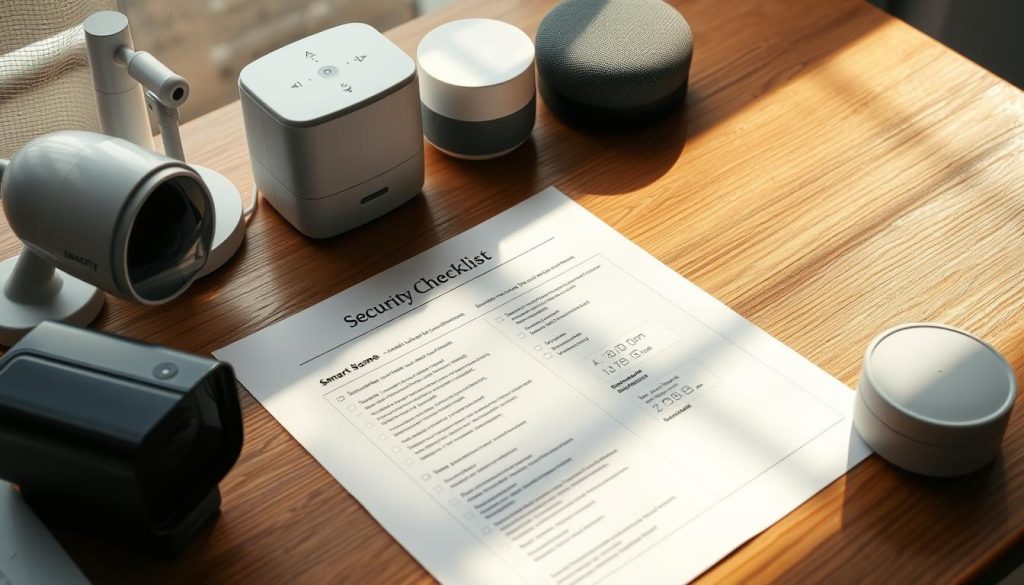More than a dozen common gadgets in a single household can quietly collect and share data, and many people consent without realizing it through defaults or long policies.
Today’s connected home includes TVs, speakers, cameras, thermostats, and appliances that talk to the internet. Some gear listens locally for wake words and then sends clips to the cloud based on settings. Apps often include third-party SDKs, so behavioral data can flow to companies beyond the maker.
That exposure is more than an abstract concern. Compromised gadgets can be used to hijack Wi‑Fi, spread malware, or enable identity theft and financial fraud. A single insecure node or gateway may open the whole network to attack.
This guide previews clear actions you can take now: update firmware, use strong unique passwords, disable always-on microphones you do not need, and harden your router and network segments to reduce attack surfaces.
Key Takeaways
- Many connected items collect and send data by default; check settings and account policies.
- Third-party code in apps can route information to outside companies.
- One compromised gadget can expose your entire network and internet link.
- Practical steps—firmware updates, strong passwords, and disabling always-on mics—cut exposure.
- Prioritize router and network segmentation to limit lateral attacks and misuse.
Why this matters now: the present-day reality of connected homes
Across U.S. residences, everyday gadgets keep sensors and connections active, ready to send streams of usage signals at a moment’s notice.
Today’s always-on ecosystem in the United States
Many products rely on continuous data generation and cloud links to deliver voice control, geofencing, and remote access. Wake‑word detection runs locally, but commands and logs often leave the house for processing.
Convenience versus control: the tradeoff we’ve accepted
Convenience features mean more information flows to companies and analytics frameworks embedded in companion apps. Those third‑party toolkits can share behavioral data beyond the maker’s walls.
- Always-on sensors: many things are sensing and ready to transmit.
- Cloud reliance: features assume constant exchange with internet services.
- Defaults matter: account and app settings often keep recordings and logs until you change them.
As product labeling like the U.S. Cyber Trust Mark gains traction, consumers will have better comparison points. For now, treat the system — hardware, network, and user settings — as a whole and start with network‑first protection.
What your devices know: TVs, speakers, cameras, thermostats, and appliances
Modern household gear collects more than you might expect. Televisions track viewing choices, remote voice commands, and — if voice features are on — ambient audio that can be sent for cloud processing and personalization.
Smart speakers listen locally for wake words, then send requests to cloud services. Depending on account settings, those interactions and recordings may be saved as logs that show questions, timing, and patterns.
Security cameras and video doorbells capture video, audio, motion events, and presence metadata. Clips and detection tags usually link to cloud accounts and mobile alerts, creating a searchable record of comings and goings.
Thermostats combine temperature, motion, schedule, and weather to learn routines, while connected appliances log cycles and error codes. Together, these functional entries reveal when people are home, asleep, or away.
- Apps and SDKs: companion apps can transmit app usage, device identifiers, and network details to third parties.
- Retention: recordings and interaction history often persist until you change settings; review dashboards and shorten retention where possible.
For a practical run‑down on what firms collect and how to limit tracking, see this guide from consumer reporting.
How you “agreed”: default settings, app analytics, and slippery privacy policies
Most setup wizards push quick acceptances that enroll your gear into wide data flows. That single tap often turns on long retention, broad sharing, and third‑party analytics without clear, granular consent.
Default data retention and voice recording options across platforms
Platform defaults vary. Google’s smart speakers, for example, may not save voice recordings by default. Other platforms keep interactions until you change settings.
App SDKs and analytics pipelines that share beyond the maker
Many apps embed analytics, crash reporting, and advertising SDKs. These toolkits send telemetry to companies beyond the original device maker.
- Setup wizards encourage fast acceptance of defaults that enable broad data collection and third‑party sharing.
- “Anonymized” logs can be reassembled by data brokers using IP addresses, identifiers, and location patterns.
- Make sure to review privacy settings after setup: reduce retention windows, disable diagnostics sharing, and separate household accounts where possible.
Long consent flows and changing privacy policy terms mean you should revisit settings periodically and audit every app and integration you use in a connected home.
Recent headlines: hacked baby monitors, listening TVs, and IoT botnets
High-profile breaches lately reveal how weak settings can turn convenience into a surveillance or attack platform. Reported cases show that poor authentication and default options make endpoints easy targets.
Baby monitor intrusions and weak authentication
Several incidents involved unauthorized viewing and two‑way audio on nursery cameras. Attackers often exploit default passwords, reused credentials, or outdated firmware.
Simple fixes—change defaults, patch before use, and enable unique account passwords—stop most opportunistic intrusions.
TVs collecting data and ambient audio concerns
Media reports have documented televisions that log viewing choices and, when voice features are enabled, capture ambient audio.
Turn off voice features if you do not need them, and review recording retention settings tied to manufacturer accounts.
When everyday gadgets become botnet soldiers
Insecure iot smart plugs, cameras, and routers have been conscripted into botnets that flood the internet with traffic.
- Attackers scan for exposed endpoints and test default logins.
- Flat home network layouts let attackers move laterally after compromise.
- Compromised gear can leak recordings, drain bandwidth, and expose your home network to abuse.
“Compromised endpoints often start with weak authentication and unpatched firmware.”
Act now: change defaults, enable MFA when offered, update firmware, and limit remote access. For wider context on rising incidents, read this report on smart device cyberattacks.
smart home spying devices privacy risks
Connected products create layered exposures. Passive collection (usage logs, telemetry, voice interactions) and active compromise (account takeover, traffic interception) sit on a single spectrum. Both let information about presence, routines, and habits escape the house.
Default settings and long privacy policy terms often authorize broad sharing. App analytics and embedded SDKs can route data to brokers beyond the original product maker. Small vendors may not test security thoroughly, increasing chances of flaws.
- Overlap: multiple items produce correlated traces that reveal daily patterns.
- Attack taxonomies: eavesdropping, MITM, sinkholes, and account takeover span hardware, network, and user layers.
- Network effect: a single compromised node can enable lateral movement across the entire setup.
Practical controls must span each layer. Minimize retention, disable unused features, and segment appliances and sensors onto separate networks. Prioritize vendors with transparent update policies and labels like the Cyber Trust Mark.
“Functional data — thermostat schedules, sensor logs, and app interactions — becomes sensitive when combined across platforms.”
Household education matters: know what is collected, where it goes, and how to change settings. Network‑first defenses materially reduce how much information leaves your homes and how easily attackers can exploit your environment.
How attacks actually happen: a smart home threat model you can understand
A single insecure gadget can be the entry point an attacker needs to map and abuse your entire household network. Think of the system as three layers: hardware, network, and user. Each layer passes information and can be an attack surface.
Hardware, network, and user layers
Hardware covers the physical products and sensors. Tampering or theft can reveal stored credentials or let a rogue clone impersonate a legit endpoint.
Network means routers, Wi‑Fi, and protocols. Unencrypted traffic invites eavesdropping, MITM interception, or sinkhole routing that reroutes your internet through a malicious node.
User covers accounts and behavior. Weak passwords, reused logins, and social engineering often give attackers initial access.

Common attack paths
- Eavesdropping: attackers read unencrypted data from sensors and logs.
- Man‑in‑the‑middle: interception changes or records traffic between a gadget and cloud services.
- Sinkhole routing: routing tricks send traffic through a malicious server for surveillance or tampering.
- Default configs: unchanged admin passwords, UPnP, or open ports speed up compromise.
From one compromised node to full exposure
Imagine a single smart plug is hijacked. An intruder uses it to reach the router’s admin page, then harvests Wi‑Fi credentials and enumerates other items on the network.
“Many attacks are opportunistic and automated; scanners look for known models and unpatched firmware.”
Defense in depth matters: encryption, strong authentication, and network segmentation break the attack chain. Isolate high-value gear like security cameras and smart speakers on separate networks and require robust passwords and updates.
- Tip: treat the router and gateway as the crown jewels — protect them first.
- Tip: automate updates and disable unused services to reduce exposure.
Beyond privacy: how unsecured devices can hijack your Wi‑Fi for malware and fraud
When an endpoint is abused, your connection can be used to spread malware or hide fraudulent activity. Attackers route malicious traffic through a compromised node so that harmful packets appear to come from your house.
From rogue traffic to identity theft and financial loss
Once inside your home network, an infected product can act as a foothold. That access lets attackers harvest credentials and stage account takeovers that lead to identity theft or financial fraud.
Malware often moves laterally, probing other things that trust the internal network. Cameras, speakers, and appliances can be targets if they share weak credentials or open ports.
- Malicious routing: your internet can proxy attacks, making your household appear responsible for fraud.
- Credential theft: seized logins let attackers drain accounts or request resets from services you use.
- Botnet enrollment: compromised units can quietly mine, send spam, or be rented for denial‑of‑service traffic.
The operational effects are real: unstable Wi‑Fi, throttled speeds, and intermittent outages from background malicious traffic. These symptoms often hide data exfiltration and reputation harm.
“A single compromised node can enable wider access across the entire home network.”
Reduce exposure now: place consumer products on a separate SSID or VLAN, disable unnecessary remote access, and enable router logging. Watch for unusual outbound connections and review account login histories.
Patch quickly and minimize exposed services; faster updates and segmentation dramatically shrink the window attackers have to hijack your network and lives.
Do-this-first security checklist: fast wins to lock down your connected home
Small, repeatable actions often stop the most common compromises before they start. Start with a few prioritized steps you can finish in minutes, then schedule regular checks to keep protections current.

Update firmware and device software on a schedule
Schedule monthly checks for firmware and app updates. Prioritize internet‑exposed cameras, doorbells, and hubs that face attackers first.
Keep a simple inventory listing each device and its last update date. Automate updates where the gateway supports automatic patching.
Use strong, unique passwords and enable MFA where available
Use a password manager to create and store strong, unique passwords for every account and device. Enable multi‑factor authentication to add a second barrier.
Store backup codes and verify account recovery methods so you can regain access if a phone or token is lost.
Disable always-on microphones, remote access, and unnecessary “features”
Turn off always-on microphones, UPnP, remote administration, and cloud backups for noncritical items. These features expand exposure without clear benefits.
Prune voice histories, camera clip retention, and diagnostic sharing to the minimum needed. Standardize setup: change default admin credentials and avoid vendor‑named SSIDs.
“A single vulnerable device can be the pivot that lets attackers map and abuse your network.”
- Review third‑party app integrations quarterly and remove unused apps.
- Factory‑reset and remove accounts from gear you retire or sell.
- Make sure built‑in privacy dashboards are used to delete old data after updates.
Quick wins: monthly updates, strong passwords with MFA, and disabling nonessential features will cut most exposure and buy you time to harden the network.
Fortify the network: your strongest defense against hidden threats
The gateway on your router often decides whether an intrusion stays outside or spreads inside. Start with a network‑first mindset: protect the router, then isolate other items and monitor traffic.
Core configuration steps
Change defaults immediately: new admin username and a strong passphrase. Enable WPA3 when available; use WPA2 with a long passphrase if not. Turn off WPS and disable UPnP and remote admin.
Segment and limit access
Create a separate SSID or VLAN for IoT and consumer products so laptops and phones do not share the same local network. Use a guest network for visitors to reduce exposure.
Monitor, update, and harden the gateway
Enable automatic firmware updates on the router and turn on DNS filtering with a reputable resolver to block known malicious domains. Add firewall rules to restrict inbound traffic and stop internal items from talking to unnecessary external hosts.
- Monitor traffic for spikes or foreign connections, especially from cameras or unknown endpoints.
- Keep router configuration backups and document segments for fast recovery.
- Review connected clients periodically and quarantine anything you don’t recognize.
“Segmentation and a hardened gateway limit pivoting and sinkhole-style attacks.”
Shop and manage with privacy in mind
Choosing gear starts with understanding how a product manages updates, account access, and data retention.
Look for transparent practices and labels. Prefer companies that publish security update policies, promise multi‑year support, and participate in labeling programs such as the U.S. Cyber Trust Mark. Larger vendors often publish security reports, but independent research and community testing also matter.
Read settings like a pro and audit apps regularly
Review privacy settings before you connect. Check recording retention, opt‑out options for analytics, and whether the app shares data with partners or brokers.
- Scrutinize app permissions — disable location, microphone, or contacts unless required.
- Choose products that support MFA, local‑only modes, and encrypted transport.
- Audit apps quarterly: remove unused apps, revoke permissions, and reset tokens you no longer need.
Fit every purchase into your network model. Decide if a product can be placed on a guest SSID or IoT VLAN and whether local control is possible to reduce cloud dependence.
“Prefer vendors that document update cadences and respond to reports quickly.”
Hold companies accountable: apply updates promptly, report issues, and favor replacements from makers with better track records. For related reading on device management and reviews, see a recent piece on the new Pixel review.
Make your connected home safer today: small steps, big protection
Spend 15–30 minutes now to update firmware, rotate passwords, and enable MFA on your most sensitive accounts and devices. These quick actions cut how much data leaves your network and raise baseline protection across a smart home.
Disable unused features such as always‑on microphones, remote admin, and UPnP. Tighten retention for recordings and logs. Put consumer gear on a separate SSID or VLAN, apply WPA3 if available, and turn off WPS to harden the gateway.
Layered defenses work: updates, segmentation, and shorter retention windows keep a single compromised node from exposing the entire household. Choose home devices with clear update policies to reduce long‑term chores.
Make a simple routine: monthly updates, quarterly setting audits, and an annual inventory. Start with your router and most sensitive device — your connected home can be safer by tonight.

